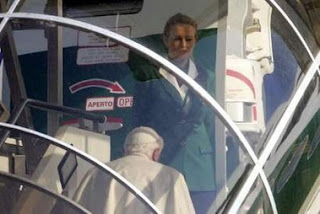Not the
Pope book yet....one more week until that is out!
So far, I've only had a chance to browse these four books...but all are very interesting and different in there own way....
1.
Mother Angelica's short pithy sayings (compiled by Raymond Arroyo) is an excellent little book that can be read in chunks--or whenever you feel you need a boost in relation to a particular area of your life. By now everyone knows about the little nun from Canton, OH who built an international Catholic network (where many more powerful entitities have failed)...and how she did it with a great deal of Faith in God. So there has to be a lot we can learn from her and there is...for example:
"If you are following God, He never shows you the end. It’s always a walk of faith.”
If you know Mother's story you can see the wisdom in that saying...
2. Anthony DeStefano's Ten Prayers God Always Says Yes To: Divine Answers to Life's Most Difficult Problems
is an excellent little book that could serve as a primer on what is really important to pray about--namely how God wants me to live my life with all the reality that it brings. Too often prayer is addressed to God in a way that is asking God to make me something else, rather than make me what I am and give me the tools to do it with joy. DeStefano gives a good foundation here and then neatly ties it all together with a prayer at the end of the book that incorporates the "ten" prayers all into one.
3.
The Physics of Christianity
by
Frank J. Tipler would not be a book that I normally would even pick up, but I when I did--I found a wealth of very accessible answers to the big questions that people's faith often hinges upon...like the problem of evil and free will (something that Einstein rejected). I have to think that this book is a must read for anyone involved in apologetics--explaining the faith to a modern world. Great insights here and the possibility of seeing the world in a different light.
4. Scott Hahn's latest offering is an apologetic book, but as he told me a few monthis ago when I asked him about it, not your typical apologetics book. This is a book that helps you through Scott's own story to learn to look for answers as to why do we believe as we do (you might want to also check out Father Benedict Groeschel's little book
Why Do We Believe
?). Written in the very accessible way that all Hahn books are this will please both longtime fans and those who haven't been exposed to him yet. Faith is not unreasonable, and here Scott gives you a reason to believe!









 We began watching this last night (movie totals close to 3 hours)and it would be hard to describe it accurately, but I'll try. I think what this movie does, not with words (because there are hardly any) is to immerse you into the silence of the Carthusians. I think you will get more out of this beautiful movie if you first read the excellent book written about the English Carthusians at Parkminster,An Infinity of Little Hours: Five Young Men and Their Trial of Faith in the Western World's Most Austere Monastic Order
We began watching this last night (movie totals close to 3 hours)and it would be hard to describe it accurately, but I'll try. I think what this movie does, not with words (because there are hardly any) is to immerse you into the silence of the Carthusians. I think you will get more out of this beautiful movie if you first read the excellent book written about the English Carthusians at Parkminster,An Infinity of Little Hours: Five Young Men and Their Trial of Faith in the Western World's Most Austere Monastic Order From Vultus Christi:
From Vultus Christi:





 One wonders if the pope sees in his election as pope a similar path when he says this of Augustine's ordination "The beautiful dream of the contemplative life disappeared, Augustine's life fundamentally changed. Now he had to live with Christ for all." No Bavarian retreat to contemplate the truth, but a mission to share the truth to the world!
One wonders if the pope sees in his election as pope a similar path when he says this of Augustine's ordination "The beautiful dream of the contemplative life disappeared, Augustine's life fundamentally changed. Now he had to live with Christ for all." No Bavarian retreat to contemplate the truth, but a mission to share the truth to the world!